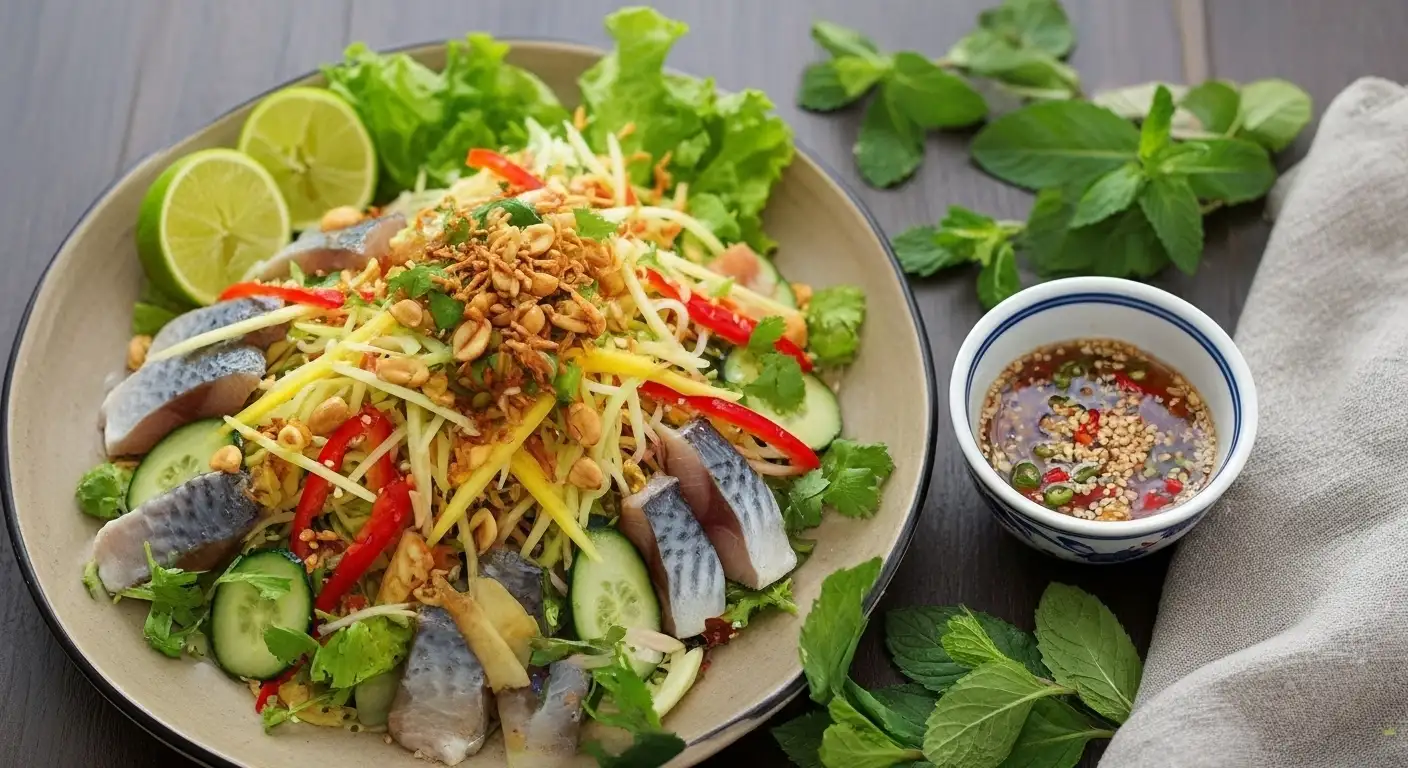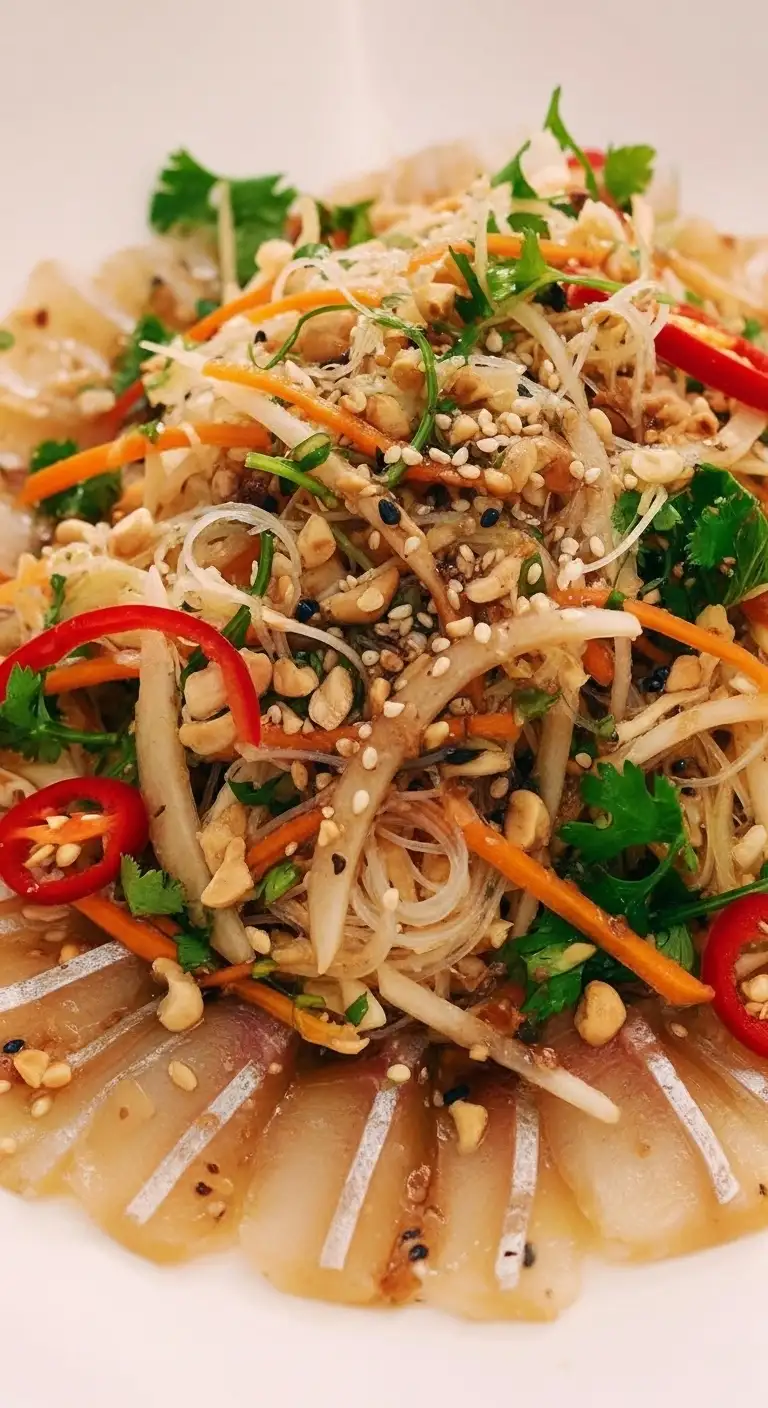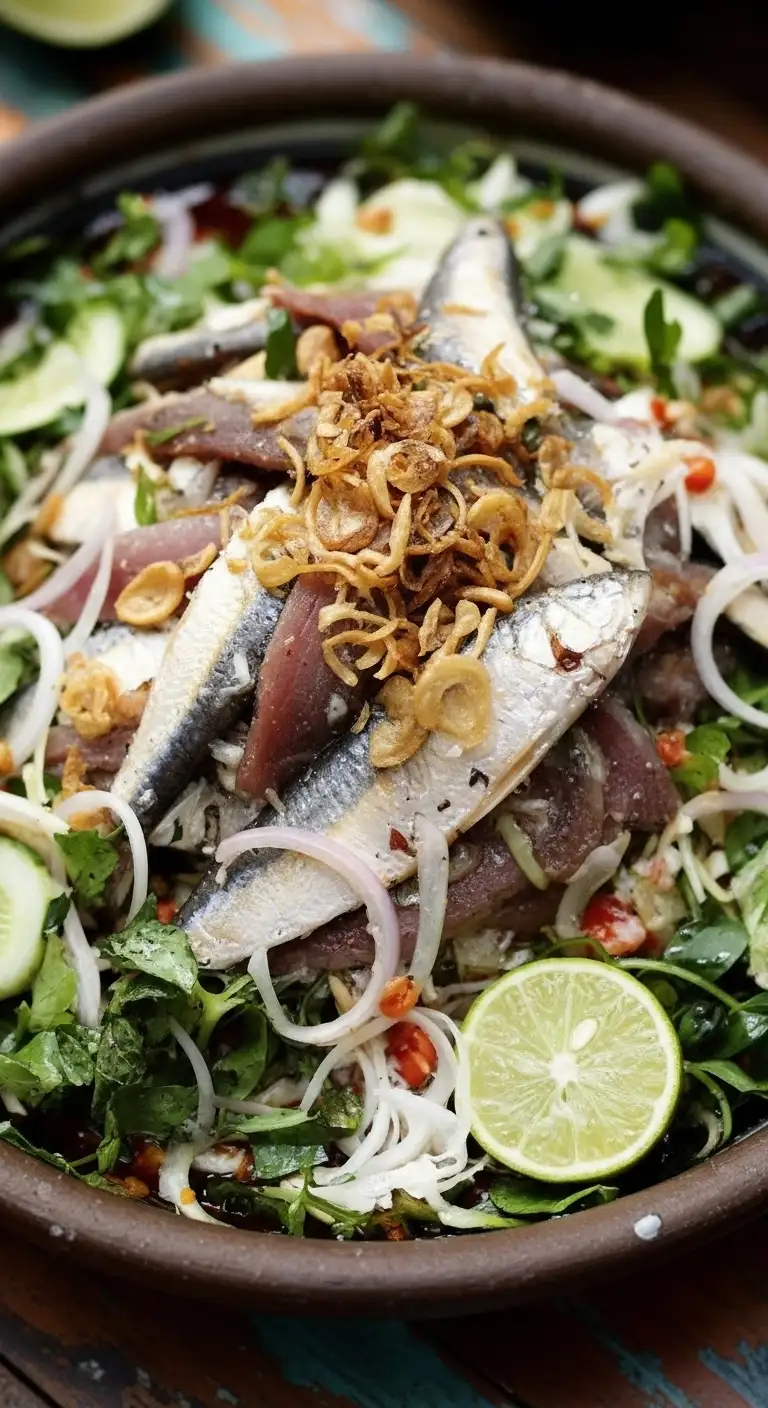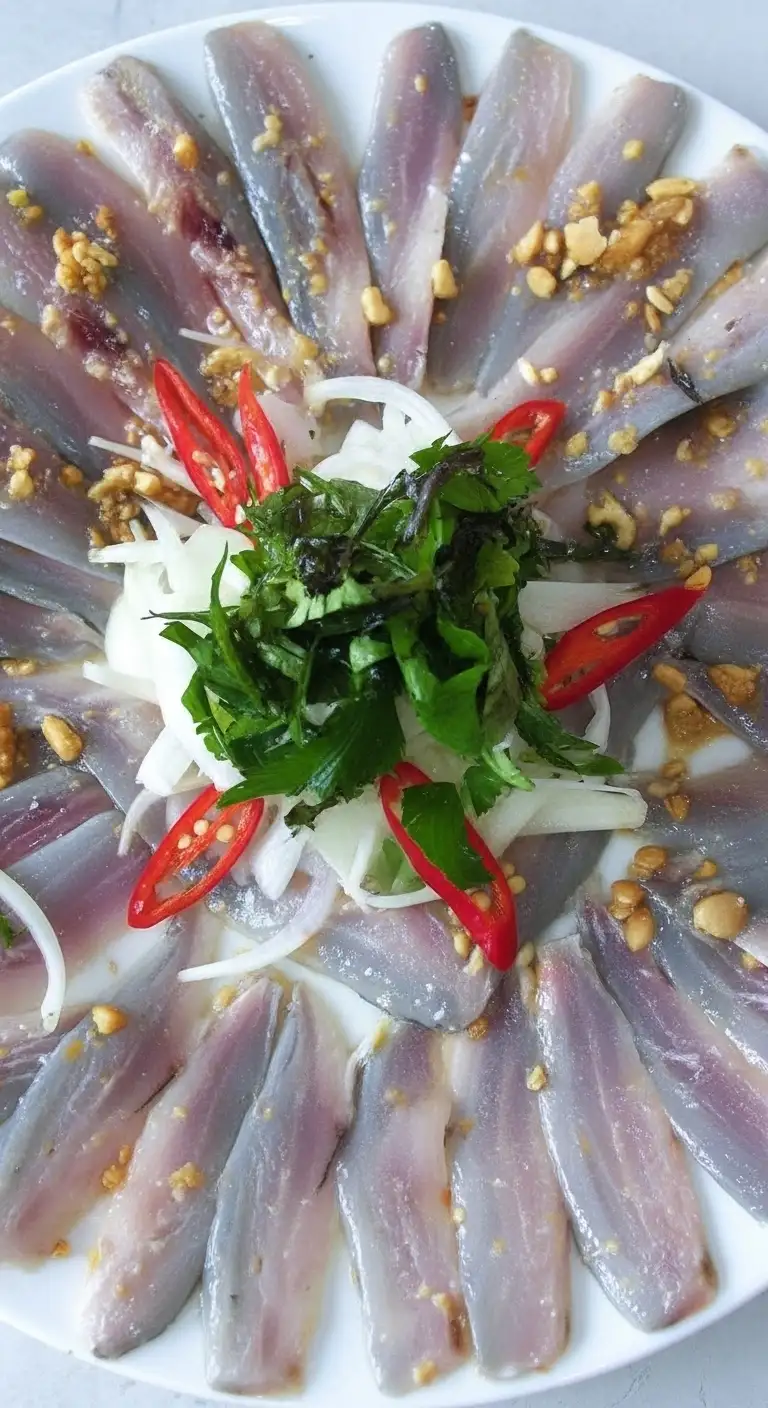Gỏi Cá is one of the most exciting and specialized dishes in Vietnamese cuisine. Literally translating to “fish salad,” it is the local version of a raw fish preparation, similar to ceviche or sashimi, but distinctively Vietnamese in its elaborate assembly of fresh herbs, complex dipping sauces, and rolling ritual.
Basic Information on Gỏi Cá
What is Gỏi Cá?
It is a traditional Vietnamese raw fish salad. It typically consists of thinly sliced, fresh fish that has been “cooked” using acidity (lime juice or vinegar) and/or blended with savory ingredients like thính (toasted, ground rice/rice powder) and aromatic herbs.
The Fish: The type of fish depends entirely on the region and the freshest catch. Common choices include Cá Mai (White Sardine/Anchovy), Cá Trích (Herring), or various sand borer species.
The Preparation:
The fish must be absolutely fresh. It is filleted, deboned, and thinly sliced.
The slices are often marinated briefly in lime juice or vinegar to “cure” the flesh, changing its color and texture (a process called denaturation, similar to ceviche).
It is then mixed with other ingredients, such as shredded ginger, galangal, chili, and the essential thính (toasted rice powder), which absorbs moisture, adds a nutty aroma, and gives the fish a delightful, slightly sandy texture.
Significance:
Gỏi Cá is highly regarded as a regional specialty, particularly in coastal areas. Its preparation requires skill and trust in the freshness of the ingredients, making it a celebratory dish often shared communally.
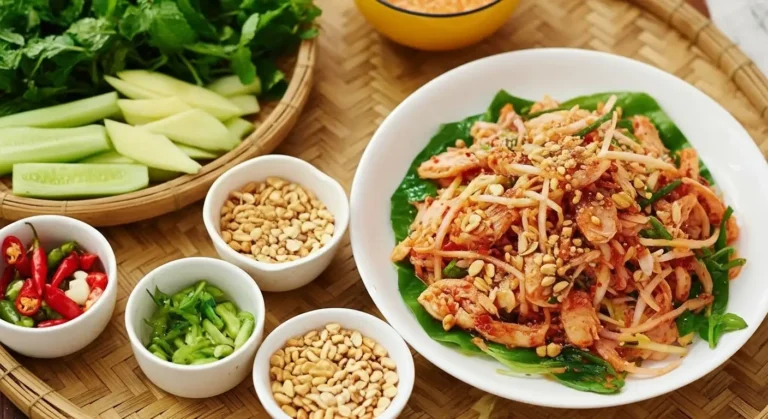
Types of Gỏi Cá Dishes
The category of Gỏi Cá is diverse, with dishes named after the region or the primary fish used:
Gỏi Cá Mai (White Sardine Salad):
A Central Vietnamese specialty, famously from coastal towns like Phan Thiết and Nha Trang. It uses small, tender white sardines. The preparation is renowned for its specific, rich dipping sauce made from the fish marinade, fermented rice, ripe banana, and often crushed peanuts, giving it a thick, nutty consistency.
Gỏi Cá Trích (Herring Salad):
A signature dish of Phú Quốc Island and the Mekong Delta. The raw herring is mixed with shredded fresh coconut, onion, and herbs, creating a light, sweet, and fragrant salad that is perfectly paired with the island’s famous fish sauce.
Gỏi Cá Nam Ô (Nam Ô Fish Salad):
The specific, well-known Gỏi Cá of Đà Nẵng (Central Vietnam). It is famous for its elaborate dipping sauce (nước chấm) made from the boiled, seasoned fish stock, tapioca flour for thickening, and intense flavors of chili and galangal. This version is intensely spicy and aromatic. It often comes in two styles: gỏi khô (dry, tossed with thính) and gỏi ướt (wet, tossed with the dipping sauce).
How to Eat Gỏi Cá
Gỏi Cá is rarely eaten as a simple bowl of salad; it is enjoyed through an intricate and interactive process involving rolling and dipping.
The Rolling Ritual:
Diners are typically presented with a platter of the marinated fish, a large selection of fresh herbs, vegetables, and, most importantly, bánh tráng (thin rice paper wrappers).
The Process: Take a sheet of rice paper, layer it with a variety of herbs (which often include strong-flavored leaves like fig leaves, star fruit, and banana blossom), add cucumber slices, a slice of green banana, and finally, a generous portion of the Gỏi Cá. The whole package is then tightly rolled up.
The Dipping:
The rolled parcel is then dipped into the signature regional sauce. The sauce is crucial, as it provides the final balance of sweet, sour, salty, and spicy notes needed to complement the raw fish and the multitude of herbs.
Serving:
It is often served with Bánh Tráng Nướng (grilled girdle rice paper), a crispy, crunchy cracker that adds a textural contrast to the soft fish roll.
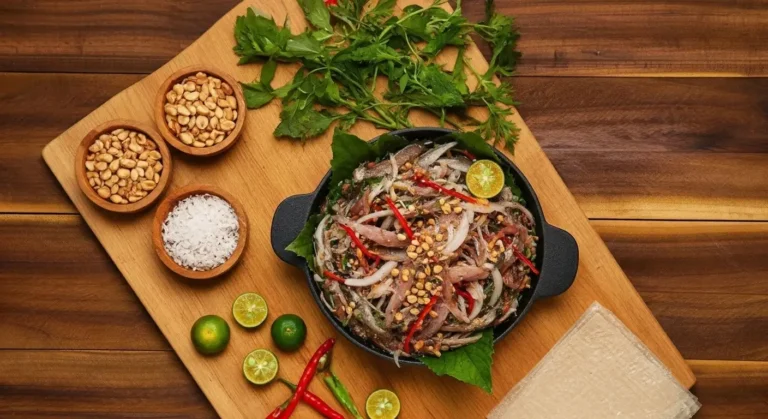
Regional Differences
The core concept of Gỏi Cá remains the same throughout Vietnam (raw fish served with herbs), but the flavors, choice of fish, and especially the dipping sauce vary significantly.
| Region | Flavor Profile & Characteristics | Key Dipping Sauce & Accompaniments |
|---|---|---|
| North (Nộm) | Subtle & Aromatic. Northern salads are generally called Nộm. While raw fish salad (Gỏi Cá in the Northern sense) exists, it is less common than in coastal areas. When made, it tends to be lighter, using local fish and often relying on fresh ginger and chili for flavor. | A balanced, savory Nước Chấm (classic fish sauce dip), which is less sweet and less spicy than Southern versions. |
| Central (Đà Nẵng, Nha Trang, Phan Thiết) | Intense, Spicy, & Complex. This is the heartland of Gỏi Cá. The flavors are bolder, heavier on the chili, galangal, and garlic. The fish is often heavily coated with thính (toasted rice powder). | The sauce is the star: Thick, Nutty, and Aromatic (often made with banana, tamarind, and fish stock) with a strong, spicy kick. It is served with the widest variety of wild and exotic local leaves. |
| South (Phú Quốc, Vũng Tàu) | Sweet, Fresh, & Herbaceous. Southern cuisine often incorporates a touch more sugar. The focus is on the freshest catch, like herring, mixed with creamy shredded coconut for sweetness and texture. | A sweeter and tangier Nước Chấm with a heavy reliance on the sourness of lime. The famous Phú Quốc Fish Sauce is the essential base. |
